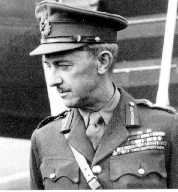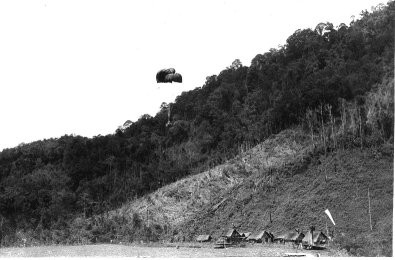After the Japanese Surrender in 1945, the M.P.A.J.A. was disbanded and over 5,000 arms were handed in. However, a secret branch, about 4,000 strong, remained in being and kept their arms. It was the intention of the Malayan Communist Party (M.C.P.) to gain control of Malaya, using their secret force if other means failed. Their political expedients proved unsuccessful, and in May, 1948, they embarked on an armed insurrection, calling themselves the Malayan Races Liberation Army (M.R.L.A.), the majority of whom were former members of the M.P.A.J.A. They were, and are still, eighty per cent Chinese, the remainder being Malays, Indians, Indonesians and Siamese. Most of the officers had had previous military experience in the M.P.A.J.A.
There is, in addition to the M.R.L.A., the Min Yuen or Peoples Movement, whose function is to raise funds by subscription, extortion or robbery, to collect supplies of every kind, to act as couriers, to collect information, to disseminate propaganda and recruit new members for the party. The Min Yuen is extremely well organised and their intelligence system has been one of the greatest obstacles to the Security Forces’ success. Since 1949 many Min Yuen have been armed.
The strength of the M.R.L.A. in 1953 was believed to be still about 5,000, with some 1,500 armed Min Yuen (or Armed Work Force). It is, of course, impossible even to estimate the strength of the Min Yuen, although it is safe to say that its strength varies considerably according to the success of the Security Forces.
The terrorists are armed chiefly with rifles, sten-guns, carbines, pistols, hand grenades, and a few bren guns. It is generally considered that they are now short of ammunition. Webbing equipment is largely home-made, and considerable ingenuity has been shown in the repairing of weapons and the making of ammunition.
Their food and supplies are usually obtained by the Min Yuen from the local Chinese population. Some terrorists live off Sakai aborigines deep in the jungle, others have made an effort to start cultivation areas in the jungle, but the amount of food produced in this way is relatively small.
The progress of the re-settlement scheme for moving Chinese squatters into the towns and New Villages, together with more effective food control by the Security Forces, has had a definite effect, and the evidence of surrendered terrorists shows that many Units are short of food. This has tended to make the units break up into small parties and has also led to a considerable increase in the number of surrenders.
Many of the armed Min Yuen live in their villages, but the M.R.L.A. Units invariably live in camps on the jungle fringe, near to their source of food and supplies. Some headquarters and training camps are deep in the jungle, and may accommodate as many as three hundred men. They have been known to have parade grounds, assault courses and elaborate sanitation and cooking arrangements. These camps usually have dug-in positions and are strongly defended.
Orders and instructions are passed by couriers, although the postal and telephone services have sometimes been used. There have been unconfirmed reports of terrorist wireless activity, but it is most unlikely that they have any serviceable transmitters. Civilian receivers have been found in many terrorist camps, and with these it is easy to tune into the military nets.
Particularly at lower levels their operational intelligence is extremely good. Most of the information is provided by the Min Yuen, whose organisation is such that any move of the Security Forces in or near populated areas will be reported immediately, and the news will reach terrorists units in a surprisingly short time. The local military commander invariably takes great pains to deceive the Min Yuen, but the problem of moving troops from their bases to the scene of operations, without the terrorists receiving a timely warning, is one of the most difficult which face the Security Forces. The terrorists, on the other hand, are often in a position to intimidate the local population so that their own movements are not given away.
The Communists do not possess sufficient stocks of materials to maintain the uniformity of dress, but most of M.R.L.A. wear khaki or green drill, sometimes with Japanese-type puttees and rubber ankle boots. The only standard piece of uniform is a five-pointed khaki or green cap with a five-pointed red or yellow star in front.
Periodically the Central Executive Committee issues a tactical directive, but these are often grandiose and impractical documents, and in practice the local commander will evolve his own methods. Generally speaking, the terrorist attacks are by ambush or hit-and-run raids, directed against Security Forces, police stations, rubber estates, tin mines, or buses and trains in remote parts. They usually choose unprotected targets, or at least those against which they can count on numerical superiority.
The M.P.A.J.A. was only trained as a guerilla force and was never a serious threat to the Japanese, although it had a considerable nuisance value. The present fighting value of the M.R.L.A. is very variable. Weapon training and marksmanship are poor, but discipline and jungle craft are of an extremely high order. Their general behaviour corresponds exactly with the Western conception of the Oriental mentality. They are fanatical and, although inexperienced, good at living on their wits. They have outstanding powers of endurance and can bear hardship to a far greater degree than the European. Though outwardly courageous and apparently bold, they are not brave in adversity. Their discipline is harsh by our standards and based on fear and bullying. The death sentence is not uncommon. Morale at the beginning of the Emergency was high, and was supported by clever propaganda. But events have not fulfilled the early expectations. None of the main objects of the insurrection have been achieved, food and supplies become increasingly difficult to obtain, many of their number are killed or die of wounds and disease in the jungle. In spite of this, it should be remembered that the hard core are known to be fanatical Communists, who will not surrender, and who will have to be hunted out and exterminated.
The difficulties involved in fighting the Communist terrorists are broadly similar to those encountered in any guerilla warfare. The guerillas have a potential ally in every member of the population, from whom they are themselves often indistinguishable. They can assemble at will, stage an incident, and, before the regular troops arrive, the guerillas will have disappeared, leaving the soldiers to strike at thin air. The military commander is compelled to deploy forces far out of proportion to the size and apparent importance of the guerillas, while the individual soldier, tired of chasing an enemy with whom he can rarely get to grips, may soon be demoralized and become a prey to his ever watchful opponent.
In Malaya, patrols are usually carried out by platoons, operating independently or in conjunction with other platoons. Battalion operations are not uncommon and even brigade operations are occasionally mounted. Depending on the circumstances an operation might last a few hours or several weeks.
The armament of patrols varies considerably according to the type of operation, but in a section there is always at least one bren gun. Some grenade-firing rifles are carried.
Basically, there are three ways by which a patrol might kill terrorists. Firstly, by ambush. This is usually the most successful method, provided that the ambush is well laid and the marksmanship is good. Secondly, by a chance encounter whilst moving through jungle or rubber. This type of contact will consist of an exchange of shots between leading men on either side, and the terrorists will probably disappear before the main body of the patrol can be deployed. The third type of action is the attack on a terrorist camp. This is extremely difficult to do successfully, as often the camp cannot be accurately located, and the approaches are invariably so well guarded that a sentry will probably spot the patrol and give the alarm before the patrol gets within striking distance.
The fact that Companies and Platoons were spaced out over a large area emphasized the great importance of communications. Malaya is one of the worst places in the world for operating wireless, and at the beginning of the Emergency it was not considered possible to obtain communication between a jungle patrol and its base. But experience showed that with good training and the use of special techniques, reliable communications could be maintained.
By his firm and energetic action the High Commissioner, General Sir Gerald Templer, has succeeded in preventing the emergency from becoming a hopeless stalemate. He is gradually gaining the confidence of the people, although the majority of the Chinese still seem apathetic and indifferent to the idea of political responsibility.
The problem of the Emergency is a political one, and it will not be solved purely by military action. As soon as the people of Malaya can be persuaded to give their wholehearted support to the Government, the Emergency will end very quickly.

General Sir G. Templer

Re-supplied by air-drop